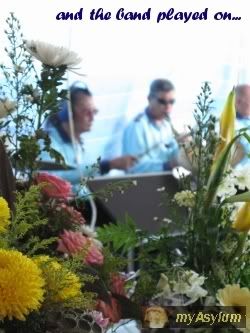In death, we celebrate life
Technorati tags: Death, Reflection, This Mortal Coil, Commonality, Life
So frail is this mortal coil… the shell within which we go through this journey we call life.
But within its frailties lies something almost herculean – the human spirit. That which makes us human, and allows us the capacity to love, hate, mourn and rejoice. Each on its own a powerful emotion. When all four converge, however, it’s difficult to describe the rollercoaster of emotions that ensue.
 Losing someone close to you, the passing itself and all the rituals that follow, is one of those tumultuous times. As Walski experienced last week.
Losing someone close to you, the passing itself and all the rituals that follow, is one of those tumultuous times. As Walski experienced last week.
For reasons of privacy, Walski won’t reveal who the person was, nor how the person was related to him and the Mrs – suffice it to say that it was someone close. Close enough that we had to be there. Walski had already mentioned previously how the family member died. And it’s not Walski’s intention to elaborate further about the passing, except to say that the time between diagnosis and death was very short, and because of that, there was no long term suffering. For this small mercy, we are thankful.
Funerals, in general, are somber affairs. That’s probably a no-brainer. Walski’s not entirely sure about other cultures, but there is a stark difference between Malay/Muslim funerals and Taoist/Buddhist ones. In a way, Walski feels privileged that being in a cross-cultural marriage, he gets to learn and contrast the things that make us unique as communities. Funerals is definitely one of them.
For the Malay/Muslims, visible grief is discouraged, and for the more traditional families, it’s not uncommon for someone who is too expressive with their grief to get a telling off. The other big difference is that the time span between death and burial is kept to a minimum – “the sooner the better” being the general modus operandi. So it’s not uncommon for family members flung far and wide to not get the opportunity to see their deceased loved ones one final time before burial.
Quite the contrary with Taoist/Buddhist funerals. Traditionally, the number of generations the dearly departed leaves behind determines the length of time the body lies in state. Three, five or seven days are the typical durations between death and burial. The person in question was unmarried at the time of death, and so traditionally, it would have been 3 days. But because some other close family members were abroad, it was decided to keep the body for 5 days.
What we see as differences on the surface, however, hides the many similarities between the two culturally dissimilar funerals.
(reflecting on the underlying similarities, and more, in the full post)
Grief, for one, is something that will always be there, regardless of faith or culture. And Walski personally thinks that allowing your grief to be expressed is necessary so that we can move on with our own lives eventually.
Another similarity – the coming together of family members, even those between whom some friction may exist. And those differences are set aside, at the very least, in observance of respect for the departed. Any ill feeling is shelved, even momentarily, so that the departed can be peacefully dispatched.
And because this particular family member had many friends and acquaintances, it was during the wake that we found out how this person had touched the lives of so many people. Sometimes, being close to someone makes us take for granted how many other different dimensions that person really has. Or in this case, had.
Then, you have, in the rites and rituals, another commonality. True, the specific rituals are different from one faith to the next, from one culture to another. But the necessity to observe rites and rituals, in itself, is a commonality we often take for granted.
While watching and observing the Taoist/Buddhist rituals being performed over the few days prior to the funeral, a thought occurred to Walski – that these rituals are not only for the recently departed, but also for those left behind.
All faiths believe that this life is temporary, and that it is merely a step in a larger sphere of existence. What happens after we transcend this mortal coil we will never really know until it’s our own time, but all faiths believe in a hereafter. Of one form or another.
For the Taoist/Buddhists, it’s reincarnation. And so, the rites and rituals make for a smoother transition. For the Muslims, the funeral rites are akin to last-minute provisions that the deceased is given as cosmic credits to be redeemed in their favor at the time of judgment.
But in both cases, the living, too, get something out of it – peace of mind that their final obligation to their loved one has been fulfilled. In a way, some sort of closure to know that you’ve done your bit.
And what that closure allows us to do is to move on with our own lives.
In coming together to pay our last respects, we do one other thing, many times quite unknowingly. We celebrate life – not just that of the one who just left us, but life in general. Death is part and parcel of our existence in this plane – it is a step in a bigger journey. For the living left behind, it is a reminder that one day our time, too, will come for us to transition to the next plane. But until that day comes, it is a reminder to make the best of what little time we have remaining.
To make the best of our lives, as we humanly can...
Post choppiness apology footnote: This post has been a very difficult one for Walski to write. And he begs your pardon if it seems kinda choppy. As a small consolation, he leaves you with this hauntingly beautiful rendition of Tim Buckley’s Song to the Siren, performed by a collective of artists from the 4AD label, who call themselves, quite aptly, This Mortal Coil.
May your soul find the peace that this life it couldn’t…
















